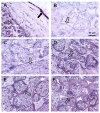Differential transferrin expression in placentae from normal and abnormal pregnancies: a pilot study
- PMID: 18597674
- PMCID: PMC2459177
- DOI: 10.1186/1477-7827-6-27
Differential transferrin expression in placentae from normal and abnormal pregnancies: a pilot study
Abstract
Background: The placenta is an important site for iron metabolism in humans. It transfers iron from the mother to the fetus. One of the major iron transport proteins is transferrin, which is a blood plasma protein crucial for iron uptake. Its localization and expression may be one of the markers to distinguish placental dysfunction.
Methods: In the experimental study we used antibody preparation, mass spectrometric analysis, biochemical and immunocytochemical methods for characterization of transferrin expression on the human choriocarcinoma cell line JAR (JAR cells), placental lysates, and cryostat sections. Newly designed monoclonal antibody TRO-tf-01 to human transferrin was applied on human placentae from normal (n = 3) and abnormal (n = 9) pregnancies.
Results: Variations of transferrin expression were detected in villous syncytiotrophoblast, which is in direct contact with maternal blood. In placentae from normal pregnancies, the expression of transferrin in the syncytium was significantly lower (p < 0.001) when compared to placentae from abnormal ones (gestational diabetes, pregnancy induced hypertension, drug abuse).
Conclusion: These observations suggest that in the case of abnormal pregnancies, the fetus may require higher levels of transferrin in order to prevent iron depletion due to the stress from the placental dysfunction.
Figures




Similar articles
-
Immunological studies of transferrin and transferrin receptors of human placental trophoblast.Placenta. 1980 Jan-Mar;1(1):33-46. doi: 10.1016/s0143-4004(80)80014-2. Placenta. 1980. PMID: 6255455
-
Trophoblast transferrin and transferrin receptors in the host--parasite relationship of human pregnancy.Proc R Soc Lond B Biol Sci. 1979 Mar 26;204(1154):83-97. doi: 10.1098/rspb.1979.0014. Proc R Soc Lond B Biol Sci. 1979. PMID: 37515
-
Fibroblast growth factor-2 and fibroblast growth factor receptor-1 mRNA expression and peptide localization in placentae from normal and diabetic pregnancies.Placenta. 1998 Mar-Apr;19(2-3):133-42. doi: 10.1016/s0143-4004(98)90001-7. Placenta. 1998. PMID: 9548179
-
Iron deficiency during pregnancy: the consequences for placental function and fetal outcome.Proc Nutr Soc. 2014 Feb;73(1):9-15. doi: 10.1017/S0029665113003637. Epub 2013 Nov 1. Proc Nutr Soc. 2014. PMID: 24176079 Review.
-
Differential expression of several factors involved in placental development in normal and abnormal condition.Placenta. 2020 Jun;95:1-8. doi: 10.1016/j.placenta.2020.04.006. Epub 2020 Apr 20. Placenta. 2020. PMID: 32339142 Review.
Cited by
-
Transcriptome-wide analysis of changes in the fetal placenta associated with prenatal arsenic exposure in the New Hampshire Birth Cohort Study.Environ Health. 2019 Nov 21;18(1):100. doi: 10.1186/s12940-019-0535-x. Environ Health. 2019. PMID: 31752878 Free PMC article.
-
Proteome profiling of human placenta reveals developmental stage-dependent alterations in protein signature.Clin Proteomics. 2021 Aug 9;18(1):18. doi: 10.1186/s12014-021-09324-y. Clin Proteomics. 2021. PMID: 34372761 Free PMC article.
-
The extent of postpartum cardiac reverse remodeling is reflected in urine proteome.Sci Rep. 2024 Jun 27;14(1):14815. doi: 10.1038/s41598-024-65612-1. Sci Rep. 2024. PMID: 38937573 Free PMC article.
-
Proteomic biomarkers of preterm birth risk in women with polycystic ovary syndrome (PCOS): a systematic review and biomarker database integration.PLoS One. 2013;8(1):e53801. doi: 10.1371/journal.pone.0053801. Epub 2013 Jan 29. PLoS One. 2013. PMID: 23382852 Free PMC article.
-
Overlap of proteomics biomarkers between women with pre-eclampsia and PCOS: a systematic review and biomarker database integration.Hum Reprod. 2015 Jan;30(1):133-48. doi: 10.1093/humrep/deu268. Epub 2014 Oct 28. Hum Reprod. 2015. PMID: 25351721 Free PMC article.
References
-
- Huebers HA, Finch CA. The physiology of transferrin and transferrin receptors. Physiol Rev. 1987;67:520. - PubMed
-
- van Dijk JP. Review article: regulatory aspects of placental iron transfer – a comparative study. Placenta. 1988;8:347–354. - PubMed
-
- Zakin MM, Baron B, Guillou F. Regulation of the tissue-specific expression of transferrin gene. Dev Neurosci. 2002;24:222–226. - PubMed
-
- Verrijt CEH, Kroos MJ, Verhoeven AJM, van Eijk HG, van Dijk JP. Transferrin in cultured human term cytotrophoblast cells: Synthesis and heterogeneity. Mol Cell Biochem. 1997;173:177–181. - PubMed
-
- Chaudhary J, Skinner MK. Comparative sequence analysis of the mouse and human transferrin promoters: Hormonal regulation of the transferrin promoter in Sertoli cells. Mol Reprod Dev. 1998;50:273–283. - PubMed
Publication types
MeSH terms
Substances
LinkOut - more resources
Full Text Sources
Medical
Miscellaneous

